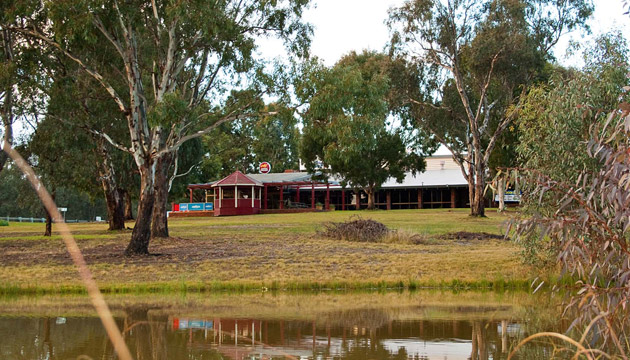Whether or not there’s water in the lake at Bonnie Doon, the taps in Victoria’s Bonnie Doon Hotel never run dry.
Story By Ken Eastwood
Talk about a thirsty land. A huge scoop of Lake Eildon beside the Bonnie Doon Hotel that has been as dry as a drover’s throat for about 15 years is now brimming. The water laps under the Bonnie Doon Bridge, in the north-west corner of the Victorian lake, and on still mornings it reflects the area’s quiet farmland, isolated holiday houses and huge powerlines made famous by the 1997 Aussie film The Castle.
Inside the quirky pub sits caravan-park owner Ray Octigan, having a few pots with his mates. Although he’s been living at Bonnie Doon since 1995, he won’t call himself a local. “I’m only a new boy – I’ve only been here 16 years,” he says.
Originally a Melburnian, Ray bought the caravan park – which had waterskiers making up the bulk of its holiday clientele – just months before the region entered its long period of drought. “When we first come here, from Melbourne Cup weekend to Easter, it was full every weekend,” he says. “They came to waterski that back part of the lake where there are no trees and there’s flat water. Not long after I bought the place it entered a long drought, and I’d just bought a water-based business. The furthest the water has been was 13 kilometres from here. The lake has been as low as three percent, eight percent.”
Ray says that since the water returned mid-last year, trade went up 100 percent, and peak holidays in 2012 are already booked out. The pub, too, saw an immediate increase in passing trade, with some day-trippers driving the two-and-a-half hours north-east of Melbourne just to see water under the Bonnie Doon Bridge.
The brick pub was built in 1980 and, although a little ho-hum on the outside, has plenty of character – and characters – on the inside. The main bar has horseshoes branded into the woodwork, and several stables’ worth of saddlery, harnesses, bridles and other riding gear hanging from the exposed timber beams. There are some unusual mounted animals: a pig, a goat and, oddly, a kudu from South Africa. There is a huge fireplace and two large contrasting aerial photos over the mantelpiece – one showing the area in 2000, with no water to be seen, and the other in 2011.
This story excerpt is from Issue #80
Outback Magazine: Dec/Jan 2012










